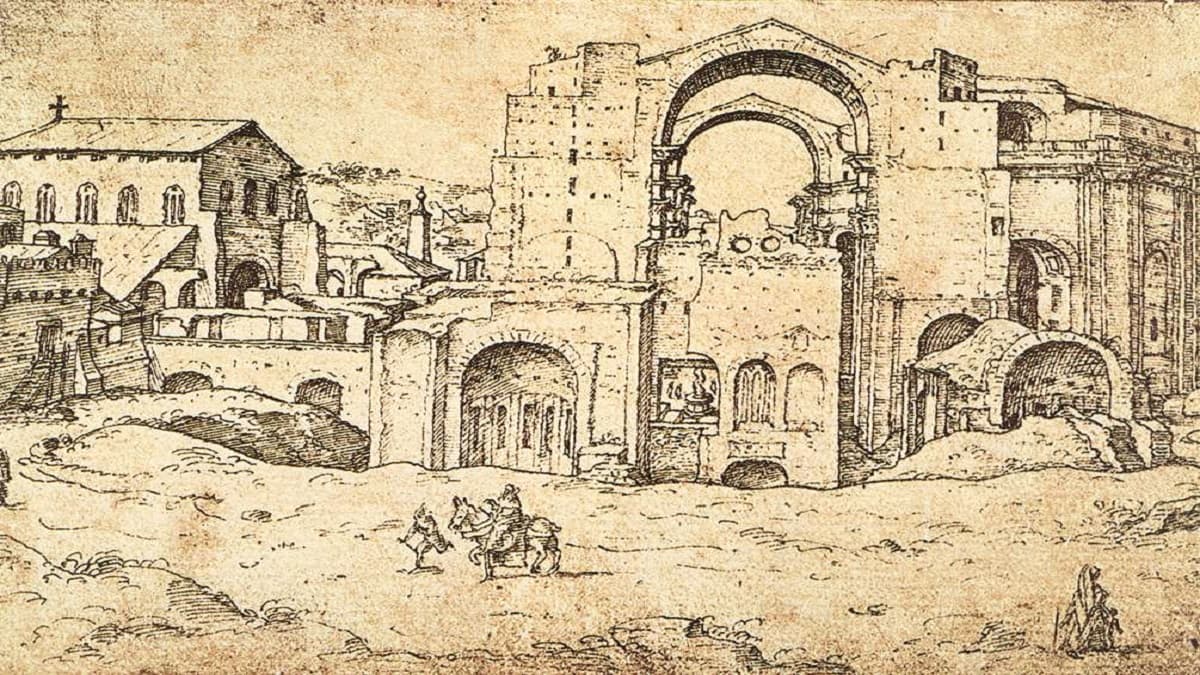If today Basilica of St. Peter is considered the symbol and centre of Christianity, centuries ago that role belonged to another basilica. The Basilica of Constantine, also known as the Old Basilica of St. Peter in the Vatican, was founded in the 4th century and stood for 1200 years. It too was erected over the tomb of the Prince of the Apostles, and like the current Basilica, was always teeming with pilgrims.
In hoc signo vinces, Constantine’s choice
The Old Basilica was built by Emperor Constantine. Contrary to legend, Constantine was not the first Christian Emperor. This belief spread as Constantine himself claimed to have seen the Latin cross and the inscription “In hoc signo vinces”, “In this sign you will conquer”, in a dream just before the battle of Ponte Milvio. Actually, Constantine saw the Christian God in the same way as the many other pagan Gods he worshipped. If he converted, it was on his death bed.
What is true is that, through Emperor Constantine, Christians were finally grantedfreedom of worship. Furthermore, the Emperor gave the followers of this new religion buildings and lands in which they could gather and celebrate liturgical services.
The location chosen for the Basilica dedicated to St. Peter presented several technical and bureaucratic problems. The land was slopingand already home to a necropolis that was still in use. Roman law guaranteed the inviolability of burial-places, but the Emperor was able to impose his willand authorised the Basilica’s construction, while ensuring that the tombs were not damaged.
If Constantine tackled all these problems in order to build on top of the necropolis, it was because he wanted to construct a Basilica above the tomb of Peter the Apostle, the father of the Church.
Constantine’s decision proved inspired. The Basilica was completed in the mid 4th century and soon became the principal destination for Christian pilgrims, along with Jerusalem.
The beating heart of the church was a small aedicule in the shape of a fireplace. At the time, it was believed to contain the remains of St. Peter. The emperor had it enclosed in a funerary monument, made of finemarble and red porphyry. The monument was topped by a baldachin with four beautiful 2nd century twisted columns.
The world’s largest and most beautiful church
Constantine’s Basilica quickly became the most important church in Christianity. Christians would come to Rome from everywhere to kneel in front of the sepulchre of Peter the Apostle. It was also the largest Basilica ever built and home to numerous artistic masterpieces. If today we have a precise idea of what it looked like, it’s because of the many artists that were inspired by it and chose to depict it in their works.
The façade with its three doorways was not particularly appealing, but directly behind it was a four-sided portico so beautiful it was nicknamed Paradise. At the centre of this courtyard stood a four-metre-tall bronze cone-shaped fountain. This imposing fountain was located inside an eight-columned baldachin. Two marvellous golden bronze peacocks and other dolphin-shaped sculptures decorated its roof. The Basilica was 120 metres long and was divided into 5 separate naves by tall Corinthian columns.
The activities that took place in the old Basilica were very different to those of today’s Church. Papal celebrations were rare and other ceremonies of pagan origins were held, such as the refrigerium: a commemorative banquet that would take place on the anniversary of the death of the deceased. There are accounts of refrigeriums with so many guests that they filled up both the Basilica and the portico, spilling out onto the steps and the square below it. The Basilica was open 24 hours a day and resembled a town square more than a church.
The Basilica continued to evolve throughout its 1200-year existence. The popes that followed left their mark as they embellished the church in attempts to outdo their predecessors. They covered the floors and walls with precious materials, and commissioned works of art from the greatest artists of their respective times.
Masterpieces of the Old Basilica
Among the many masterpieces housed in the Old Basilica until the 15th century, there were 12 spectacular columns that surrounded St. Peter’s funerary monument. During the Middle Ages, it was thought that they came from the Temple of Solomon. One column in particular was named the Holy Column because it was believed to have been the column that Jesus leant on during his sermons.
Since the coronation of Charlemagne in 799, Emperors started going to the Basilica to be crowned by the Pope. The exact spot where the ceremony would take place was marked by a large red porphyry disc; the rota porphiretica that is now located in the new St. Peter’s Basilica.
Giotto’s famous Navicella mosaic, on the other hand, was not located inside the church, but on one of the four sides of the portico. Being exposed to the elements, it was repeatedly damaged and had to be almost completely remade.
The list of artworks found inside the Old Basilica of Saint Peter is very long, with many of them now housed in the new Basilica. Among these are: the precious wooden and ivory chair traditionally thought to have been used by Peter as Bishop of Rome, but then dated to the Carolingian era; two important statues of the Apostle – one in marble from the classical era, the other made of bronze from the 13th century; and the gate of Filarete, dating back to 1445.
Many other wonders, such as most of the frescoes that adorned the Basilica, were sadly lost.

Vox City, The Vox Group's Dedicated Business-To-Consumer Arm For The Past Five Years, Is Staffed By Veteran Travel Industry Experts With A Combined 21 Years Of Expertise In The Tourism Industry. Let's Explore The Beauty Of Travel In Your Own Way At Your Own Pace.
Vox City International 63 Holly Walk | CV32 4JG Leamington Spa
2025 Vox City, All rights reserved.





